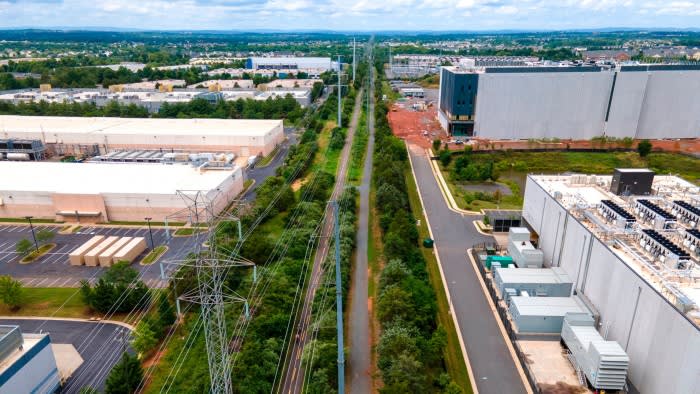Stay informed with free updates
Simply sign up to the Technology sector myFT Digest — delivered directly to your inbox.
Water consumption by dozens of facilities in Virginia’s “data centre alley” has jumped by almost two-thirds since 2019, as environmental campaigners warn that demand for computing infrastructure is set to “explode” due to artificial intelligence.
The US state of Virginia is home to the world’s largest concentration of data centres, including facilities used by Big Tech groups Amazon, Google and Microsoft.
The vast warehouses full of computers and networking gear used at least 1.85bn US gallons (7bn litres) of water in 2023, according to records obtained by the Financial Times via freedom of information requests.
That compares with the 1.13bn gallons used in 2019, according to the data provided by six authorities in Fairfax, Loudoun, Prince William and Fauquier counties in and around the area known as “data centre alley” in northern Virginia. There are additional water providers in the region not captured by the data.
The trend in Virginia “raises questions about how sustainable this is”, given the “explosive growth [in data centres] we’re expecting in the next few years”, said Julie Bolthouse, director of land use at the Piedmont Environmental Council, a non-profit based in the state.
Big Tech is investing tens of billions of dollars into data centres globally in the race to develop AI, which is hugely power- and compute-intensive but which the likes of Google and Microsoft hope will become a lucrative revenue stream in the next era of computing.
Overall, US data centres consumed more than 75bn gallons of water in 2023, roughly equivalent to the amount that London, the UK capital, consumes in four months, according to estimates by research group Dgtl Infra.
Water is used by data centres to cool computing equipment, and also in most forms of fuel and power generation. Some of these vast computing facilities are located in water-stressed regions or areas, including parts of Virginia that are suffering from droughts.
Loudoun officials said the amount of land in the county dedicated to data centres had more than doubled since 2019, with a substantial additional area under construction.
Bank of America estimated in November that data centres are the tenth-largest water consumer in the US. Big individual facilities can consume millions of gallons per month, though tech companies are trying to reduce the intensity of their usage, including by using reclaimed and recycled water.
Google’s water consumption rose 14 per cent in 2023, which it said in its latest environmental report was primarily due “to water cooling needs at our data centres”.
In its disclosures to the FT the Prince William County Service Authority, a local utility provider, said the combined water consumption of the 35 operational data centres in the county in 2024 amounted to about 6 per cent of the authority’s maximum-day demand. The number of facilities has risen 59 per cent since 2019.
Fairfax Water only disclosed usage information for the two data centres that were among its 100 biggest customers, so all 11 facilities in the county are not captured by the data. The county has 12 data centre applications pending.

This year, the Virginia Department of Environmental Quality approved the transfer of a permit from an old power station to Amazon that will allow the tech company to withdraw up to 1.4bn gallons per year from the Rappahannock River to cool a new data centre campus on the old industrial site.
Authorities set daily, monthly and annual limits that permit holders can use without harming the waterbody from which the water is withdrawn. Actual usage is typically below those limits.

Environmental groups have pointed out that data centres can be located in water-stressed areas. Microsoft said 42 per cent of the water it consumed globally came from “areas with water stress” in 2023. Google said that 15 per cent of its global freshwater withdrawals came from areas with “high water scarcity”. Amazon has not reported a comparable number.
Virginia has suffered several record breaking dry-spells in recent years, as well as a “high impact” drought in 2023, according to the US National Integrated Drought Information System. Much of the state, including the northern area where the four counties are located, is at present in drought or suffering from abnormally dry conditions, according to the US Drought Monitor.
Amazon said it was “committed to being a good water steward” and that its data centre business would be “water positive” by 2030, meaning the company will return more water to communities than it uses in direct operations. Microsoft and Google have made similar commitments. Microsoft said it was working to reduce the amount of water used for cooling and from August “new data centres we design for Virginia will use zero-water cooling technologies”. Google declined to comment.
Climate Capital

Where climate change meets business, markets and politics. Explore the FT’s coverage here.
Are you curious about the FT’s environmental sustainability commitments? Find out more about our science-based targets here


